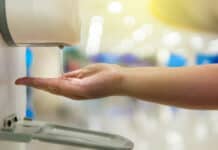By Allen Rathey
Like most disruptive technology introduced to the cleaning sector, on-site generation of Electrochemically Activated (ECA) cleaning solutions has been questioned and faced skepticism: How well does it clean? Disinfect? If it doesn’t smell, bubble, or have a color, how do I know it’s working?
For readers not familiar with ECA cleaning, this process uses water as the cleaning agent. ECA controls water pH by first “softening” or conditioning water, augmenting it with salt, then splitting the resulting mildly acidic and alkaline cleaning solution streams using sophisticated membranes that remove most of the salt to result in very pure solutions. ECA is an advancement over common “electrolyzed water” that blends the streams. This is because the process splits the cleaning from the sanitizing or disinfecting streams and stores them in separate tanks for on-demand use; solutions remain effective for 30 days or more. Blending streams potentially dilutes performance and may lead to degradation of active ingredients.

ECA solutions have become an important part of the professional cleaning toolbox because:
- On-site generated cleaners and disinfectants can replace up to 97% of packaged cleaning products, yielding quick ROI, especially via equipment rental programs.
- They promote sustainable practices by eliminating buying and offsite production, packaging, shipping, storing, and handling of legacy solutions.
- Leading ECA systems produce both a Green Seal-certified multipurpose cleaner and a short-dwell-time EPA-Registered disinfectant, in separate streams with 30-day or greater shelf life, and which work as well as national brands.
ECA Proof Of Performance
How do you know it’s working? The proof is in the pudding. In this case, the dish served is clean buildings, and the recipe is standardized best practices, since ECA, like any other tool, must be used properly to work optimally.
Beyond cleaning properly for appearance, using handheld measurement devices to quantify how well surfaces are cleaned can verify hygienic processes in the field. Showing the removal of bioburden and organic soil, enables a “health snapshot” of the facility’s cleaning and baseline data for continuous improvement. This article will cover the use of ATP devices to prove that ECA cleaning is working.
How ATP Works

ATP meters measure adenosine triphosphate (ATP) in relative light units (RLUs) on surfaces before and after cleaning. While ATP is found in living cells, it’s also found in many organic soils.
According to Martin Easter, chief scientific officer of Hygiena: “ATP is present in large amounts in organic matter such as foods including harvested fruits, vegetables, and meat, and ready-to eat-foods made from such ingredients. ATP is stabilized within the cellular tissues of harvested (dead) organic matter.”
Some ATP devices can differentiate between non-microbial and microbial ATP by measuring free or soluble ATP as well as that from microbial and other organic cells.
Arriving at a “Clean Number”
Since ATP devices from different manufacturers use various numeric scales to show clean versus unclean, it is vital to standardize measurement using a specific meter model, then show a difference before and after.
For example, in one model’s scale, dirty may be >400 RLUs and clean may be <35 RLUs. Use that same meter type as the standard for all testing to show reliable data for tracking improvements to cleaning.
When “Swabbing” Is Succeeding
Swab sufficient areas and consistently for ATP data to be meaningful. This means swabbing or sampling enough surfaces to provide a meaningful snapshot, e.g., before and after, 5% of the identical or same desks in a classroom, or the same tables in a lunch room.
It is best to use a standardized template from cardboard or poster board, maybe 2”x2” placed over the area to be sampled. Use the same template size for all samples, swabbing in the same manner within the template each time. Irregular or rounded surfaces like doorknobs require a standard swabbing protocol, rather than a flat template, say, covering the entire 2”x2” area left-right, top-bottom.
Keep careful records on a paper form, in an Excel file or database, noting the ATP value, location, date, and time of each test. To ensure consistency, it is helpful if one person does all the measurement and data logging.
What ATP Can’t Do
ATP meters do not detect non-biological matter or other contaminants such as lead, asbestos, pesticides, and chemical residues. Nor do they identify specific bacteria, viruses, fungi, or pathogens.
Measuring For Success
The key to both cleaning and measuring well is consistency. ECA solutions are highly effective for cleaning and disinfecting when used as directed in a standardized program. Similarly, used in a standardized way, ATP devices provide a data set and paper trail demonstrating your ECA cleaning program not only cleans for appearance but hygienically by removing biological materials that may be harmful to staff and occupants.





















![[VIDEO] Collect Asset Data at the Speed of Walking a Building](https://facilityexecutive.com/wp-content/uploads/2024/02/maxresdefault-324x160.jpg)